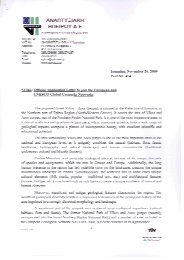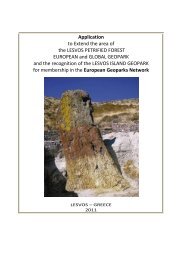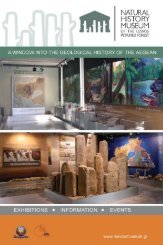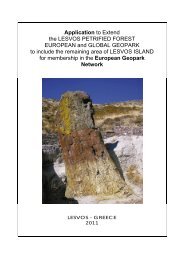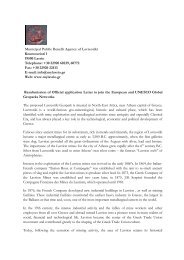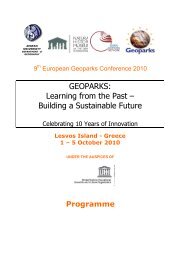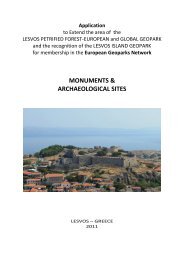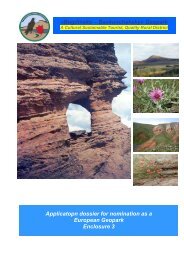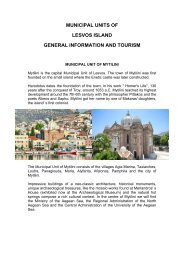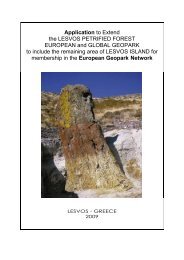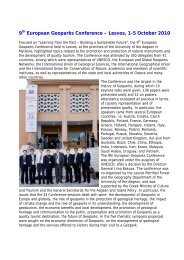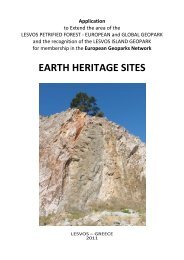LESVOS: The island of nature and culture
LESVOS: The island of nature and culture
LESVOS: The island of nature and culture
You also want an ePaper? Increase the reach of your titles
YUMPU automatically turns print PDFs into web optimized ePapers that Google loves.
Application to Extend<br />
the <strong>LESVOS</strong> PETRIFIED FOREST<br />
EUROPEAN <strong>and</strong> GLOBAL GEOPARK<br />
to include the remaining area <strong>of</strong> <strong>LESVOS</strong> ISLAND for<br />
membership in the European Geopark Network<br />
<strong>LESVOS</strong> - GREECE<br />
2009
NATURE AND CULTURE OF <strong>LESVOS</strong> GEOPARK<br />
<strong>LESVOS</strong>: <strong>The</strong> <strong>isl<strong>and</strong></strong> <strong>of</strong> <strong>nature</strong> <strong>and</strong> <strong>culture</strong><br />
Description<br />
Located in NE Aegean sea, Lesvos is the third largest Greek <strong>isl<strong>and</strong></strong> covering an area<br />
<strong>of</strong> 1630 km 2 with a population <strong>of</strong> 100.000 inhabitants.<br />
Map <strong>of</strong> Lesvos showing the actual Lesvos Petrified Forest European <strong>and</strong> Global<br />
Geopark.<br />
<strong>The</strong> <strong>isl<strong>and</strong></strong> is well known for its antiquities, the medieval castles, its traditional<br />
villages, its <strong>culture</strong>, the ancient olive groves, the pine forests, the vast variety <strong>of</strong> birds<br />
<strong>and</strong> wildflowers, the hot springs <strong>and</strong> the famous Petrified Forest.<br />
<strong>The</strong> <strong>isl<strong>and</strong></strong> is the birthplace <strong>of</strong> famous people <strong>of</strong> art <strong>and</strong> literature like the philosopher<br />
<strong>The</strong>ophrastus, the singer <strong>and</strong> guitar-player Arion, Sappho <strong>and</strong> Alkaeo, Pittako, <strong>and</strong><br />
finally, the great painter Jakobidis, the Nobel prize winner Elitis <strong>and</strong> some other who<br />
made history in their own way.<br />
Lesvos is blessed with award-winning beaches , traditional villages, more varieties <strong>of</strong><br />
birds <strong>and</strong> wildflowers than anywhere in Europe, pine forests, medieval castles, scenic<br />
harbors with cafes <strong>and</strong> inexpensive seafood restaurants , abundant fish, museums<br />
including two <strong>of</strong> the finest art museums in Greece, hotels <strong>of</strong> every class <strong>and</strong><br />
category, <strong>and</strong> some <strong>of</strong> the warmest, friendliest people in all <strong>of</strong> Greece.<br />
Lesvos has been a favourite location for artists, writers <strong>and</strong> romantics. Its natural<br />
attractions include the unique Petrified Forest , the impressive hot springs, <strong>and</strong><br />
health inducing spas that are dotted around Lesvos. Many have been in use for<br />
thous<strong>and</strong>s <strong>of</strong> years for rheumatism, arthritis, gynaecological <strong>and</strong> dermatological<br />
ailments, as well as kidney <strong>and</strong> gallstones, neurological ailments, bronchitis <strong>and</strong><br />
sciatica. Lesvos' wonderful l<strong>and</strong>scapes can be seen by donkey or horseback, cycling,<br />
jeep, or on foot. If you prefer to be on water there are yachts for charter. <strong>The</strong>
NATURE AND CULTURE OF <strong>LESVOS</strong> GEOPARK<br />
numerous festivals held throughout the <strong>isl<strong>and</strong></strong> <strong>of</strong> Lesvos, are enjoyed <strong>and</strong> celebrated<br />
in their traditional ways, with the locals displaying their flair for dancing, drinking <strong>and</strong><br />
eating, hours on end, days on end.<br />
<strong>The</strong> visitor <strong>of</strong> Lesvos in the spring will be amply rewarded with one <strong>of</strong> the most<br />
incredible displays <strong>of</strong> wildflowers <strong>and</strong> wild birds you will ever see. Lesvos is a main<br />
stop in the migration routes for European birds coming from Africa <strong>and</strong> has an<br />
amazing variety <strong>of</strong> local birds. From the fantastic beach town <strong>of</strong> Skala Eressos to the<br />
progressive yet traditional village <strong>of</strong> Molyvos whose ancient walls were once<br />
beseiged by Achilles himself, Lesvos is simply amazing in its natural environment,<br />
archaeology, scenery <strong>and</strong> lifestyle.<br />
History<br />
<strong>The</strong> rich mythology <strong>of</strong> the <strong>isl<strong>and</strong></strong> started when the leader <strong>of</strong> Lesvos, Makaras, gave<br />
the name <strong>of</strong> his son-in-law, Lesvos, to the <strong>isl<strong>and</strong></strong>. During that period the first cities<br />
were founded <strong>and</strong> were named after Makara's daughters, Mytilini, Issa, Antissa,<br />
Mithimna, Arisbi <strong>and</strong> Eressos, which was named after the son <strong>of</strong> Makara, Eresos.<br />
Homer mentions to his poems that the story <strong>of</strong> the <strong>isl<strong>and</strong></strong> begun during the first years<br />
<strong>of</strong> the Trojan War <strong>and</strong> Brisiida who was the cause <strong>of</strong> Achilles' anger against<br />
Agamemnon when he stole her from him.<br />
Researches have shown that the <strong>isl<strong>and</strong></strong> was inhabited since the Neolithic period with<br />
the presence <strong>of</strong> a remarkable civilization during the period <strong>of</strong> the copper.<br />
Exhibits show that the <strong>isl<strong>and</strong></strong>'s civilization was influenced by the neighbouring Troy.<br />
<strong>The</strong> ancient history <strong>of</strong> the <strong>isl<strong>and</strong></strong> begun in 546 BC, when the Persians dominated the<br />
<strong>isl<strong>and</strong></strong>. After a series <strong>of</strong> battles <strong>and</strong> revolutions they finally managed to set the <strong>isl<strong>and</strong></strong><br />
free in 472 BC by taking part in the Athenian alliance. <strong>The</strong> Athenians <strong>and</strong> the<br />
Spartans later dominated Lesvos.<br />
In 88 BC the Romans dominated it. This is the beginning <strong>of</strong> a period where the <strong>isl<strong>and</strong></strong><br />
managed to gain some kind <strong>of</strong> autonomy from the Pompeio because <strong>of</strong> the historian<br />
<strong>The</strong>p<strong>of</strong>anis Mitilinaios.<br />
After the division <strong>of</strong> the Roman Empire <strong>and</strong> during the Byzantine period, the <strong>isl<strong>and</strong></strong><br />
has successively sacked the Slaves, Sarakinous, Venetians <strong>and</strong> Crusades. <strong>The</strong><br />
<strong>isl<strong>and</strong></strong> was under the domination <strong>of</strong> Gatelouzos in 1354 where art, education <strong>and</strong><br />
trade were developed during his domination.<br />
Biodiversity<br />
<strong>The</strong> <strong>isl<strong>and</strong></strong> <strong>of</strong> Lesvos is a richly endowed l<strong>and</strong>. Its natural beauties, its climate <strong>and</strong> its<br />
fertile soil have given birth to people with a pr<strong>of</strong>ound sense <strong>of</strong> beauty <strong>and</strong> harmony,<br />
from the depths <strong>of</strong> antiquity right up to the present. It is not by chance that even<br />
during mythological times Lesvos was known for its flourishing arts.<br />
Due to its reach biodiversity Lesvos <strong>isl<strong>and</strong></strong> includes three protected areas which<br />
belong to the European Νetwork Natura 2000, “Geras gulf <strong>and</strong> Mt. Olympus<br />
GR4110005”, “Kalloni gulf wetl<strong>and</strong>s GR4110004” <strong>and</strong> “Petrified forest - Western<br />
peninsula GR4110003”<br />
In the eastern part <strong>of</strong> Lesvos a rather moist climate prevails, in comparison with the<br />
rest <strong>of</strong> the <strong>isl<strong>and</strong></strong>.<br />
<strong>The</strong> slopes <strong>of</strong> Mt. Olympus <strong>and</strong> the Amalis peninsula dominate the morphology, while<br />
in between them is the tectonic basin <strong>of</strong> the Gulf <strong>of</strong> Yera with impressive steep cliffs<br />
on its eastern side.<br />
Plants at lower elevations are typical <strong>of</strong> Mediterranean maquis plants,<br />
characteristically consisting <strong>of</strong> evergreen bushes (2-2.5 meters in height) with tough
NATURE AND CULTURE OF <strong>LESVOS</strong> GEOPARK<br />
leathery leaves adapted to the Mediterranean climatic conditions. <strong>The</strong>se plants<br />
include holly, mastic, wild olives, wild pear etc. At higher elevations on the slopes <strong>of</strong><br />
Mt. Olympus, the flora changes to plants which have adapted to the more damp <strong>and</strong><br />
cold climatic conditions. Myrtle, laurel, maple etc. grow here, as well as cultivated<br />
tree crops rarely found on Greek <strong>isl<strong>and</strong></strong>s such as the chestnut groves <strong>of</strong> Agiassos<br />
<strong>and</strong> cherry, apple <strong>and</strong> pear orchards.<br />
In the middle part <strong>of</strong> the <strong>isl<strong>and</strong></strong> are located the Kalloni wetl<strong>and</strong> ecosystem covering a<br />
huge expanse that includes many smaller wetl<strong>and</strong>s.<br />
<strong>The</strong>re is an impressive variety <strong>of</strong> plant life on the <strong>isl<strong>and</strong></strong> including oak trees, wild<br />
pistachios, wild roses, walnut, almond, fig <strong>and</strong> apple trees as well as herbs like<br />
Melissa, mint, sage <strong>and</strong> aniseed. <strong>The</strong> Rhododendron luteum, can also be found here,<br />
the only place it grows in Europe.<br />
In the middle part <strong>of</strong> the <strong>isl<strong>and</strong></strong> are located the Gera <strong>and</strong> Kalloni wetl<strong>and</strong> ecosystems<br />
covering a huge expanse that includes many smaller wetl<strong>and</strong>s. <strong>The</strong>y are ecosystems<br />
full <strong>of</strong> salt-pans, rivers, reed bushes, olive groves <strong>and</strong> pine forests <strong>and</strong> a very rare<br />
variety <strong>of</strong> orchids.<br />
<strong>The</strong> areas are under the protection <strong>of</strong> the European network Natura 2000. Many<br />
birds, some rare or protected, breed here. Sixty-six species <strong>of</strong> migratory birds have<br />
been recorded <strong>and</strong> 68 species <strong>of</strong> birds live here on a permanent basis including<br />
Flamingo (Phoenicopterus ruber), the Kingfisher (Alcedo atthis), the Avocet<br />
(Recurvirostra avosetta), the Black-winged Stilt (Himantopus himantopus), the Great<br />
White Egret (Egretta alba), the White Stork (Ciconia ciconia), the Black Stork<br />
(Ciconia nigra). <strong>The</strong>re is an information centre <strong>and</strong> special observatories where one<br />
can observe <strong>and</strong> not disturb. Also nearby are the wetl<strong>and</strong>s <strong>of</strong> Polychnitos, home to<br />
the rare species <strong>of</strong> squirrel (Sciurus anomalus).<br />
<strong>The</strong> Petrified Forest protected area<br />
On the western part <strong>of</strong> Lesvos Isl<strong>and</strong>, remains <strong>of</strong> fossil plants appear within volcanic<br />
rocks. <strong>The</strong> fossils comprise the well-known «Lesvos Petrified Forest», which covers<br />
an area <strong>of</strong> 15,000 ha. Within this area, several unique palaeo-botanical sites showing<br />
high concentrations <strong>of</strong> fossilised tree-trunks have been discovered.<br />
<strong>The</strong> region <strong>of</strong> the Petrified Forest is characterized by impressive volcanic geotopes,<br />
result <strong>of</strong> the intense volcanic activity <strong>of</strong> the past. This region could be characterized<br />
as a window on the geohistoric development <strong>of</strong> the Aegean over the past 20 million<br />
years.<br />
Due to its great ecological value, a large part <strong>of</strong> western Lesvos is included in the<br />
“Natura 2000” list <strong>of</strong> important areas for natural protection in the European Union,<br />
under the name the “Petrified Forest – Western Peninsula <strong>of</strong> Lesvos” (GR 4110003).<br />
Scientists researching <strong>and</strong> studying the Petrified Forest speak enthusiastically <strong>of</strong> the<br />
rarity <strong>and</strong> great scientific value <strong>of</strong> the monument <strong>and</strong> repeatedly emphasize the<br />
uniqueness <strong>of</strong> the site. <strong>The</strong>re are many reasons for this. <strong>The</strong> Petrified Forest<br />
constitutes an entire forest ecosystem that was fossilised on the spot because <strong>of</strong><br />
intense volcanic activity. <strong>The</strong> large number <strong>of</strong> fossilised trunks that have remained<br />
st<strong>and</strong>ing upright, with their root system fully developed, confirms that the trees were<br />
fossilised in their original position, thus this is an autochthonous fossilised forest.<br />
<strong>The</strong> fossilised trees <strong>and</strong> the parts <strong>of</strong> the plants have been preserved in excellent<br />
conditions up to the present. <strong>The</strong> age <strong>of</strong> the forest <strong>and</strong> the great variety <strong>of</strong> fossilised<br />
plant species that have been found contribute to its great scientific value, whereas<br />
the composition <strong>of</strong> the fossilised flora is a particularly important guide to the climatic<br />
conditions, the environment <strong>and</strong> the geological conditions at that period.
NATURE AND CULTURE OF <strong>LESVOS</strong> GEOPARK<br />
<strong>The</strong> systematic paleobotanical study <strong>of</strong> the petrified tree trunks <strong>and</strong> fossilised leaves<br />
enables the determination <strong>of</strong> the genus <strong>and</strong> species <strong>of</strong> the plants that made up the<br />
forest <strong>of</strong> Lesvos 20 million years ago.<br />
At the area <strong>of</strong> Gavathas, in northwestern Lesvos, findings <strong>of</strong> the oldest known l<strong>and</strong><br />
mammal in Greece, Prodeinotherium bavaricum (first appearance <strong>of</strong> the family in<br />
Europe) have been recovered.<br />
At the Petrified Forest, we can gather information regarding the plant species which<br />
constituted the <strong>isl<strong>and</strong></strong>’s flora, the climatic <strong>and</strong> geological conditions that prevailed in<br />
the Aegean area 20 millions years ago. In other words, the Petrified Forest<br />
constitutes a unique ‘’testimonial’’ <strong>of</strong> the geological history <strong>of</strong> the Aegean basin over<br />
the past 20 million years.<br />
<strong>The</strong> Lesvos Petrified Forest is a member <strong>of</strong> the UNESCO's Global Geoparks<br />
Network <strong>and</strong> a founding member <strong>of</strong> the European Geoparks Network.<br />
Legal Protection<br />
Recognizing the great environmental, geological <strong>and</strong> palaeontological value <strong>of</strong> the<br />
Petrified Forest <strong>of</strong> Lesvos, the Greek State has initiated a series <strong>of</strong> actions for its<br />
protection. <strong>The</strong> first Ministerial decision <strong>of</strong> the Minister <strong>of</strong> Culture was published on<br />
31 January 1958 characterizing the Petrified Forest <strong>of</strong> Lesvos as a specially<br />
protected region.<br />
<strong>The</strong> expropriation <strong>of</strong> two regions <strong>of</strong> 500 acres each (at Bali Alonia <strong>and</strong> Ham<strong>and</strong>roula),<br />
containing a large number <strong>of</strong> fossilized trunks, occurred in 1965 with the decision <strong>of</strong><br />
the Minister <strong>of</strong> Agri<strong>culture</strong>.<br />
In 1985, on the proposal <strong>of</strong> the Ministry <strong>of</strong> Agri<strong>culture</strong>, the "Petrified Forest" is<br />
declared a Protected Natural Monument (PD 443/85). With this decree, one marine<br />
<strong>and</strong> four l<strong>and</strong> sections are protected. <strong>The</strong>se sections cover a large area <strong>of</strong> 150.000<br />
acres in the regions <strong>of</strong> Sigri, Antissa <strong>and</strong> Eressos, the marine section around the islet<br />
<strong>of</strong> Nisiopi or Megalonisi <strong>and</strong> four l<strong>and</strong> regions as well as individual appearances <strong>of</strong><br />
fossilized trunks. Under this law, excavation, embankment, sampling <strong>of</strong> ground <strong>and</strong><br />
geological sublayers <strong>and</strong> other actions that could cause the deterioration <strong>and</strong><br />
alteration <strong>of</strong> the geological shape <strong>of</strong> the l<strong>and</strong>scape, as well as the cutting, collection,<br />
destruction or transport <strong>of</strong> fossils, is strictly prohibited.<br />
In 1996 the Forest Police Provision regulates areas <strong>of</strong> the Petrified Forest declared<br />
Protected Natural Monuments. <strong>The</strong> Natural History Museum <strong>of</strong> the Petrified Forest <strong>of</strong><br />
Lesvos is founded by law (Law 2260/94) in 1994, its aim being the study, research,<br />
promotion, maintenance, protection, conservation, <strong>and</strong> correct use <strong>of</strong> the Petrified<br />
Forest. Presidential Degree 183/95 (96/A/30-5-1995) established its operation<br />
regulations.<br />
In 1999 (Law 2742/99 <strong>and</strong> 3044/02), the institutional framework for the protection <strong>of</strong><br />
natural regions <strong>of</strong> European Importance through the "Natura 2000 Network" is<br />
created, following the E.U. directive (92/43/EC). <strong>The</strong> region <strong>of</strong> the Petrified Forest is<br />
included among the regions that constitute the National List <strong>of</strong> the Natura 2000<br />
Network, after it was included in the Western Peninsula Lesvos - Petrified Forest<br />
region (code GR 4110003).<br />
In these regions, the maintenance <strong>of</strong> natural ecotopes as well as wild fauna <strong>and</strong> flora<br />
is promoted. <strong>The</strong> area is more specifically divided into regions containing types <strong>of</strong><br />
ecotopes identified in E.U directives, which should be maintained or, potentially, reestablished<br />
to a satisfactory level <strong>of</strong> maintenance, ecotopes <strong>of</strong> priority, as well as<br />
types <strong>of</strong> flora <strong>and</strong> fauna.
NATURE AND CULTURE OF <strong>LESVOS</strong> GEOPARK<br />
An area <strong>of</strong> 34.000 Hectares in the region has been proposed for characterization as<br />
an Area <strong>of</strong> Special Protection for Birds (Special Protected Area) according to the No.<br />
4 Directive on Birds (79/409/EOK). <strong>The</strong> proposed region has the code "GR134:<br />
South-western Peninsula-Petrified Forest <strong>of</strong> Lesvos "<strong>and</strong> it follows along the western<br />
seashores <strong>of</strong> the <strong>isl<strong>and</strong></strong> <strong>and</strong> its north to south border follows the imaginary line that<br />
links the settlements <strong>of</strong> Lapsarna, Ligeri, the Perivoli Monastery, Vatoussa, Revma,<br />
the heights <strong>of</strong> Mitero Mountain <strong>and</strong> Parakila. <strong>The</strong> region has been characterized<br />
already as an Important Region for Birds (SPP).<br />
Six locations in the region have been characterized as wildlife refuges by the Forestry<br />
Department <strong>of</strong> the Ministry <strong>of</strong> Rural Development <strong>and</strong> Food.<br />
Region<br />
Extent (str.)<br />
Skamniouda, Antissa 6000<br />
Petrified Forest, Sigri 8000<br />
Deep valley - Kelemia, Antissa 4000<br />
Nisiopi or Megalonisi <strong>of</strong> Sigri 800<br />
Mesoros - Agra 6000<br />
Maliontas - Tavari Hrousos, Mesotopo 9000<br />
In 1997, the Official Newspaper <strong>of</strong> the European Communities (l240/19-9-1997)<br />
published the Convention on the protection <strong>of</strong> the Mediterranean from pollution,<br />
namely the Convention <strong>of</strong> Barcelona, with which the coastal area <strong>of</strong> the Petrified<br />
Forest is protected.<br />
<strong>The</strong> areas <strong>of</strong> the park <strong>of</strong> the Petrified Forest Geopark were fenced <strong>of</strong>f, trails were<br />
carved <strong>and</strong> constructed into the terrain, allowing the visitor to access <strong>and</strong> view the<br />
petrified trunks.<br />
In addition, access roads, parking area, guard posts, snack bar, kiosks, cobblestone<br />
paths, rest points with wooden benches, stone water fountains <strong>and</strong> toilet facilities<br />
have been built. Local stone <strong>and</strong> wood are the principle construction materials<br />
employed for any structures in the Parks.<br />
A series <strong>of</strong> trekking paths, which link the various sites <strong>of</strong> interest together (fossil sites,<br />
volcanoes, natural, cultural <strong>and</strong> archaeological monuments), has been created by the<br />
Natural History Museum <strong>of</strong> the Lesvos Petrified Forest. <strong>The</strong>se trekking networks are<br />
known as “<strong>The</strong> lava paths” <strong>and</strong> “<strong>The</strong> olive paths”.<br />
Along the paths, appropriate rest areas have been constructed near sites <strong>of</strong> particular<br />
interest (petrified trunks, volcanic craters, major geological faults, etc.). Signs provide<br />
visitors with relevant information.<br />
<strong>The</strong> creation <strong>of</strong> a Geo-Center located at the Museum in Sigri, decentralized<br />
Information pavilions in Eresos, Gavathas <strong>and</strong> Messotopos villages <strong>and</strong> Geo-trails<br />
with explanation boards in the fossil sites <strong>and</strong> in the volcanic areas have been<br />
founded. <strong>The</strong> Geo-centre has all high-tech information systems, such as computers<br />
with CD equipment, videos, seminar rooms with all audio-visual equipment, as well<br />
as a st<strong>and</strong>ard library with literature on fossil plants, volcanism etc.
NATURE AND CULTURE OF <strong>LESVOS</strong> GEOPARK<br />
NATURA 2000 protected areas<br />
Map <strong>of</strong> the Protected areas <strong>of</strong> Lesvos Isl<strong>and</strong>.<br />
In the eastern part <strong>of</strong> Lesvos a rather moist climate prevails, in comparison with the<br />
rest <strong>of</strong> the <strong>isl<strong>and</strong></strong>. <strong>The</strong> slopes <strong>of</strong> Mt. Olympus <strong>and</strong> the Amalis peninsula dominate the<br />
morphology, while in between them is the tectonic basin <strong>of</strong> the Gulf <strong>of</strong> Yera with<br />
impressive steep cliffs on its eastern side. <strong>The</strong> rocks are mainly 300 million year old<br />
metamorphic rocks, such as the marble <strong>and</strong> schist, while on the Amalis peninsula<br />
one can find ophiolites.<br />
Plants at lower elevations are typical <strong>of</strong> Mediterranean maquis plants,<br />
characteristically consisting <strong>of</strong> evergreen bushes (2-2.5 meters in height) with tough<br />
leathery leaves adapted to the Mediterranean climatic conditions. <strong>The</strong>se plants<br />
include holly, mastic, wild olives, wild pear etc. At higher elevations on the slopes <strong>of</strong><br />
Mt. Olympus, the flora changes to plants which have adapted to the more damp <strong>and</strong><br />
cold climatic conditions. Myrtle, laurel, maple etc. grow here, as well as cultivated<br />
tree crops rarely found on Greek <strong>isl<strong>and</strong></strong>s such as the chestnut groves <strong>of</strong> Agiassos<br />
<strong>and</strong> cherry, apple <strong>and</strong> pear orchards. Pine forests can be found on the Amalis<br />
peninsula.<br />
A large part <strong>of</strong> the eastern side <strong>of</strong> the <strong>isl<strong>and</strong></strong> is covered by olive groves which blanket<br />
the hills <strong>and</strong> slopes, supported by impressive dry stonewall terraces. From a distance<br />
the border between the silver grey leaves <strong>of</strong> the olives <strong>and</strong> the dark green maquis<br />
plants <strong>and</strong> pines is quite noticeable. This ecosystem sustains a wealth <strong>of</strong> birds,<br />
reptiles, insects <strong>and</strong> mammals.<br />
<strong>The</strong> Gulf <strong>of</strong> Yera with the Dipi Marsh <strong>and</strong> Mt. Olympus make up one <strong>of</strong> the three<br />
regions <strong>of</strong> the <strong>isl<strong>and</strong></strong> which are part <strong>of</strong> a network <strong>of</strong> natural conservation called<br />
“NATURA 2000”.
NATURE AND CULTURE OF <strong>LESVOS</strong> GEOPARK<br />
In the central part <strong>of</strong> the <strong>isl<strong>and</strong></strong>, <strong>and</strong> especially around the Gulf <strong>of</strong> Kalloni, the climate<br />
becomes drier <strong>and</strong> there are plains with wheat, hay <strong>and</strong> vegetable fields.<br />
This region contains the largest gulf <strong>of</strong> the <strong>isl<strong>and</strong></strong>, the Gulf <strong>of</strong> Kalloni. To the east <strong>and</strong><br />
north <strong>of</strong> the Gulf <strong>of</strong> Kalloni, there are large mature pine forests which coincide with<br />
the borders <strong>of</strong> the ophiolitic remnants <strong>of</strong> the oceanic crust <strong>of</strong> Tethys.<br />
In the coastal area around the gulf there are 17 natural <strong>and</strong> artificial wetl<strong>and</strong>s such as<br />
the salt flats which consist <strong>of</strong> a very important system that hosts significant numbers<br />
<strong>of</strong> water birds, both migratory <strong>and</strong> non-migratory, <strong>of</strong> international interest. <strong>The</strong> area is<br />
inundated every spring by birdwatchers from all over the world.<br />
<strong>The</strong> Gulf <strong>of</strong> Kalloni is one <strong>of</strong> three regions <strong>of</strong> the <strong>isl<strong>and</strong></strong> which are part <strong>of</strong> a network <strong>of</strong><br />
natural conservation called “NATURA 2000”.<br />
In the western part <strong>of</strong> the <strong>isl<strong>and</strong></strong>, where the Petrified Forest is located, the climatic<br />
conditions change <strong>and</strong> become drier (approaching that <strong>of</strong> the Cycladic <strong>isl<strong>and</strong></strong>s), the<br />
rocks are volcanic <strong>and</strong> the mountain slopes <strong>of</strong> Mt. Ordymnos dominate the<br />
morphology <strong>of</strong> the area.<br />
<strong>The</strong> flora in this part <strong>of</strong> the <strong>isl<strong>and</strong></strong> is typical <strong>of</strong> Mediterranean frigana plants. <strong>The</strong><br />
dominant plants are small round <strong>and</strong> thorny bushes between the craggy rocks. This<br />
kind <strong>of</strong> <strong>isl<strong>and</strong></strong> flora, also found on other Aegean <strong>isl<strong>and</strong></strong>s, initially seems dry <strong>and</strong> bare<br />
looking. On closer inspection however the observer will notice a dense variety <strong>of</strong><br />
plants <strong>and</strong> animals.<br />
Thorny burnet, euphorbia sp., prickly broom, <strong>and</strong> greater knapweed constitute a<br />
continuous <strong>and</strong> thick layer <strong>of</strong> plants, which together with the rocks is virtually<br />
impassable for a hiker. For the frigana micro-environment, spring <strong>and</strong> early summer<br />
brings the blooming <strong>of</strong> a wide variety <strong>of</strong> plants such as orchids, the thirty different<br />
types <strong>of</strong> which impress the observer with eccentric shades <strong>of</strong> color. In amongst these<br />
plants there are also many fruit <strong>and</strong> insect-eating, as well as predatory, birds, rabbits,<br />
mice, turtles, impressive lizards, snakes <strong>and</strong> many more organisms which are wellhidden<br />
in between the plants <strong>and</strong> rocks. Later in the summer, a wide variety <strong>of</strong> prickly<br />
herbaceous plants <strong>and</strong> well-known thistles bloom.<br />
<strong>The</strong> oak forests are also impressive in this region. <strong>The</strong>ir acorns, once used for trade,<br />
supported the economic life <strong>of</strong> the <strong>isl<strong>and</strong></strong> at one point. This area is also criss-crossed<br />
by seasonal streams with flowering plants growing on their banks. In spring, blooming<br />
ole<strong>and</strong>ers <strong>and</strong> rhododendrons <strong>and</strong> light up the region with their pink <strong>and</strong> yellow<br />
blossoms.<br />
On this side <strong>of</strong> the <strong>isl<strong>and</strong></strong>, the careful <strong>and</strong> observant hiker may also come upon<br />
pieces <strong>of</strong> petrified trees among the rocks, bushes <strong>and</strong> volcanic ash. This area is one<br />
<strong>of</strong> three areas <strong>of</strong> the <strong>isl<strong>and</strong></strong> which are part <strong>of</strong> a network <strong>of</strong> natural conservation called<br />
“NATURA 2000”.<br />
Castles <strong>and</strong> Archaeological sites.<br />
<strong>The</strong> Molyvos Castle : <strong>The</strong> castle that crowns the heights <strong>of</strong> the town is from<br />
Byzantine times <strong>and</strong> was later repaired by Francesco Gattelusi. In terms <strong>of</strong> majesty<br />
<strong>and</strong> size it is the second most impressive on the <strong>isl<strong>and</strong></strong>. During the summer months it<br />
is used for concerts <strong>and</strong> cultural events.<br />
<strong>The</strong> Mytilini Castle: <strong>The</strong> castle located on the north side <strong>of</strong> Mytilini <strong>and</strong> overlooks the<br />
city is one <strong>of</strong> the largest in the eastern Mediterranean. It's foundations were laid<br />
during the time <strong>of</strong> Justinian on the ruins <strong>of</strong> an even older fortification which can still<br />
be seen in sections <strong>of</strong> the walls. It has been used <strong>and</strong> rebuilt by the Romans,<br />
Byzantines, Venetians <strong>and</strong> the Turks <strong>and</strong> is now used in the summer for cultural
NATURE AND CULTURE OF <strong>LESVOS</strong> GEOPARK<br />
events. <strong>The</strong>re is a Roman or Byzantine reservoir with a 4,000 cubic meter capacity.<br />
<strong>The</strong>re are also underground tunnels which cover a large area beneath the castle <strong>and</strong><br />
the hill.<br />
<strong>The</strong> Roman Aqueduct at Moria: Approximately 600 meters to the west <strong>of</strong> the village<br />
<strong>of</strong> Moria rise up the impressive arches <strong>of</strong> the great aqueduct built by the Romans. It<br />
is the remains <strong>of</strong> a fantastic technical achievement <strong>of</strong> the first 3 centuries AD, which<br />
began in the region <strong>of</strong> Agiassos <strong>and</strong> passed through the villages <strong>of</strong> Lambou Myloi<br />
<strong>and</strong> Larsos, supplying Mytilini with water.<br />
Christian Temple <strong>of</strong> Chalinados: On the agricultural region <strong>of</strong> Chalinados, about 1<br />
hour from Agia Paraskevi, are imposing ruins <strong>of</strong> an early Christian basilica <strong>of</strong> Agios<br />
Georgios which was restored by pr<strong>of</strong>essor A. Orl<strong>and</strong>os in 1937. It was originally a<br />
three-aisled basilica with a timber ro<strong>of</strong>.<br />
<strong>The</strong> Bridge at Kremasti near Agia Paraskevis was built at the time <strong>of</strong> the Gattilusi<br />
families rule over the <strong>isl<strong>and</strong></strong> between 1355 <strong>and</strong> 1462. Made entirely <strong>of</strong> stone, the<br />
bridge is a wonder <strong>of</strong> traditional architecture <strong>and</strong> is still used today. Many <strong>of</strong> Lesvos<br />
ancient sites are in the vicinity <strong>of</strong> Agia Paraskevis.<br />
<strong>The</strong> Ancient <strong>The</strong>atre in Mytilini: High up in the north side <strong>of</strong> town in the pine grove<br />
is the ancient theatre. It was one <strong>of</strong> the largest in Greece with room for 15,000<br />
spectators, considered on a par with the theatre at Epidavros. It was built in<br />
Hellenistic times though by whom is not known. It was repaired by the Romans.<br />
When Pompei visited the <strong>isl<strong>and</strong></strong> he was so excited about the theatre that he ordered<br />
a similar one built in Rome.<br />
<strong>The</strong> Yeni Mosque: This mosque in upper Skala is an example <strong>of</strong> Turkish<br />
architecture with distinct Greek features. It is in the north part <strong>of</strong> Mytilini town where<br />
first the Romans <strong>and</strong> then the Turks lived. It was built between 1823 <strong>and</strong> 1828 <strong>and</strong><br />
today has been refurbished <strong>and</strong> used as an exhibition hall.<br />
Ancient Antissa: Located on peninsula between two bays near Skalahori, this site<br />
can most easily be reached by going towards Gavatha <strong>and</strong> following the signs. <strong>The</strong>re<br />
are the remains <strong>of</strong> medieval walls <strong>and</strong> a fortress. <strong>The</strong>re are also columns <strong>and</strong> pieces<br />
<strong>of</strong> marble scattered around the valley near a small church that overlooks the beach. I<br />
assume that most <strong>of</strong> ancient Antissa lies unexcavated beneath the soil.<br />
<strong>The</strong> Sigri Castle:This castle was built in 1757 by the Turks during their occupation <strong>of</strong><br />
the <strong>isl<strong>and</strong></strong>. It sits on a small peninsula above the harbour with a view <strong>of</strong> the beach<br />
<strong>and</strong> the town. <strong>The</strong>re is no entrance fee <strong>and</strong> visitors are free to w<strong>and</strong>er around <strong>and</strong><br />
explore. <strong>The</strong>re are great tavernas <strong>and</strong> an excellent beach nearby so you can make a<br />
day <strong>of</strong> it. Also nearby is the Petrified forest.<br />
Klopedi Temple: Accessible on a trail from the village <strong>of</strong> Agia Paraskevis there are<br />
traces <strong>of</strong> an Aeolian Temple dedicated to the god Apollo.<br />
Messa Temple : An Aeolian centre <strong>of</strong> worship with some remains <strong>of</strong> an Ionic temple<br />
pavilion. Situated near the salt plains <strong>of</strong> Kaloni. if you are driving the main road from
NATURE AND CULTURE OF <strong>LESVOS</strong> GEOPARK<br />
Mytilini to Kaloni it's on the right a few minutes after you reach the valley. Follow the<br />
dirt road until you come to a small settlement <strong>and</strong> can't go any further.<br />
Church <strong>of</strong> Saint Andrew: In Eressos there are the ruins <strong>of</strong> the Church <strong>of</strong> Saint<br />
Andrew which dates back to the first half <strong>of</strong> the 5th century AD. Next to it is the<br />
archaeological museum with relics <strong>of</strong> life from the archaic era up to Byzantine times.<br />
Nearby on the hill <strong>of</strong> Vigla is the Hellenic polygonal wall, ruins <strong>of</strong> a medieval castle, a<br />
Roman cistern, two turrets <strong>and</strong> one Genovese.<br />
Ancient Pyrra: One <strong>of</strong> the 5 ancient cities <strong>of</strong> Lesvos. Located near Achladeri,<br />
remains can be seen <strong>of</strong> the town which was destroyed by an earthquake.<br />
Monasteries <strong>and</strong> Churches<br />
Many <strong>of</strong> the old Monasteries <strong>of</strong> Lesvos are still in use. Some have become<br />
destinations for pilgrimages while others carry on the spiritual traditions <strong>of</strong> long ago.<br />
Leimonos Monastery, built in 1523 is a large cluster <strong>of</strong> buildings between Kaloni<br />
<strong>and</strong> Filia. It is an important spiritual centre on the <strong>isl<strong>and</strong></strong> with a museum, a library <strong>and</strong><br />
social services. Overnight stays are possible. In Agiassos the Virgin Mary is<br />
venerated <strong>and</strong> everything revolves around the miracle working icon <strong>of</strong> the Blessed<br />
Virgin Vrefokratousa <strong>and</strong> the Church <strong>of</strong> the Panagia. During a two week period<br />
leading up to the 15th <strong>of</strong> August, which is the Holy Day <strong>of</strong> the Virgin Mary, pilgrims<br />
begin flocking to the town not only from Lesvos but all over Greece, slowly building<br />
up to a carnival-like atmosphere, peaking on the eve <strong>of</strong> the feast day. <strong>The</strong>re is<br />
another festival on September 14th commemorating the day when the Holy cross<br />
which Mytilinians brought back from Jerusalem after it was consecrated on Golgotha.<br />
Agathon's Cross was made with wood from the True Cross <strong>and</strong> is kept in the<br />
museum <strong>of</strong> the church. In M<strong>and</strong>amados at the Church <strong>of</strong> Taxiarches, the miracle<br />
working saint <strong>of</strong> the <strong>isl<strong>and</strong></strong> is worshipped. <strong>The</strong> carved icon was made by a monk<br />
using mud <strong>and</strong> the blood <strong>of</strong> his fallen comrades after being miraculously saved by<br />
Saracen pirates. <strong>The</strong> church celebrates on the third Sunday after Easter with a<br />
festival that includes the slaughtering <strong>of</strong> a consecrated bull whose meat is shared<br />
among the worshippers. Another religious celebration is held here on the third<br />
Sunday after Easter. Ypsilou Monastery is built on the crater <strong>of</strong> a dormant volcano.<br />
This monastery was built in 1101. It houses some remarkable gold embroided stoles<br />
<strong>and</strong> bible covers from 1588. It is located on the road to Sigri right past the turn<strong>of</strong>f to<br />
Eressos. From it's heights you can see the coast <strong>of</strong> Asia Minor <strong>and</strong> all <strong>of</strong> the western<br />
portion <strong>of</strong> the <strong>isl<strong>and</strong></strong>.<br />
Glyk<strong>of</strong>ylousa Panagia (Our Lady <strong>of</strong> the Sweet Kiss) sits on top <strong>of</strong> a giant rock in the<br />
centre <strong>of</strong> the town <strong>of</strong> Petra. You reach the top <strong>of</strong> the rock by climbing the 114 steps<br />
carved into the stone. From the church the view <strong>of</strong> Petra <strong>and</strong> the surrounding sea<br />
<strong>and</strong> countryside is spectacular extending all the way to the coast <strong>of</strong> Asia Minor. A<br />
beautiful legend concerning the building <strong>of</strong> the church on this high rock has come<br />
down to us: In days <strong>of</strong> old a storm bought a religious captain to the shores <strong>of</strong> the<br />
area. One morning the captain noticed that the Icon <strong>of</strong> the Blessed Virgin, which he<br />
always had with him, was missing. He looked for it everywhere but to no avail. That<br />
evening he saw a strange light shining seemingly suspended between sky <strong>and</strong> earth.<br />
He climbed up the rock <strong>and</strong> found his icon placed before a lighted lamp. He took it<br />
back to his boat but again it disappeared <strong>and</strong> again he found it on top <strong>of</strong> the rock. He<br />
decided to build a small church there since that was obviously the wish <strong>of</strong> the<br />
Blessed Virgin. <strong>The</strong> first church was built in 1609 <strong>and</strong> the present one in 1747. <strong>The</strong>re
NATURE AND CULTURE OF <strong>LESVOS</strong> GEOPARK<br />
is a great celebration there on August 15th. Below the rock is the tiny Church <strong>of</strong><br />
Agios Nikolaos. Inside, the small church is decorated with 16th century wall paintings<br />
that are colourful <strong>and</strong> inspirational <strong>and</strong> worth a trip to the village.<br />
Transportation<br />
Lesvos is easily reachable by ferry or jet from Athens <strong>and</strong> charter flights from many<br />
European cities.<br />
Sailing to Lesvos. <strong>The</strong>re are daily ships between Mytilini <strong>and</strong> Pireaus. <strong>The</strong> ferries<br />
also stop in the port <strong>of</strong> Chios for an hour or so. In the summer there is a boat from<br />
Lavrion to Sigri that takes about 6 hours <strong>and</strong> there is at least one boat a day leaving<br />
Pireaus for Chios <strong>and</strong> Mytilini, sometimes more. Several days a week the ferry<br />
continues on to Lemnos, Kavala <strong>and</strong> <strong>The</strong>ssaloniki. In the summer there is a boat that<br />
connects Lesvos with the Dodekanese <strong>isl<strong>and</strong></strong>s <strong>and</strong> Samos <strong>and</strong> sometimes Ikaria.<br />
<strong>The</strong>re are daily boats in the summer <strong>and</strong> several boats a week in the <strong>of</strong>fseason<br />
between Mytilini <strong>and</strong> Avalik in Turkey.<br />
Flying to Lesvos. <strong>The</strong>re is a jet port with at least daily flights to <strong>and</strong> from Athens.<br />
<strong>The</strong>re are also daily flights from <strong>The</strong>ssaloniki <strong>and</strong> other points in Europe.



